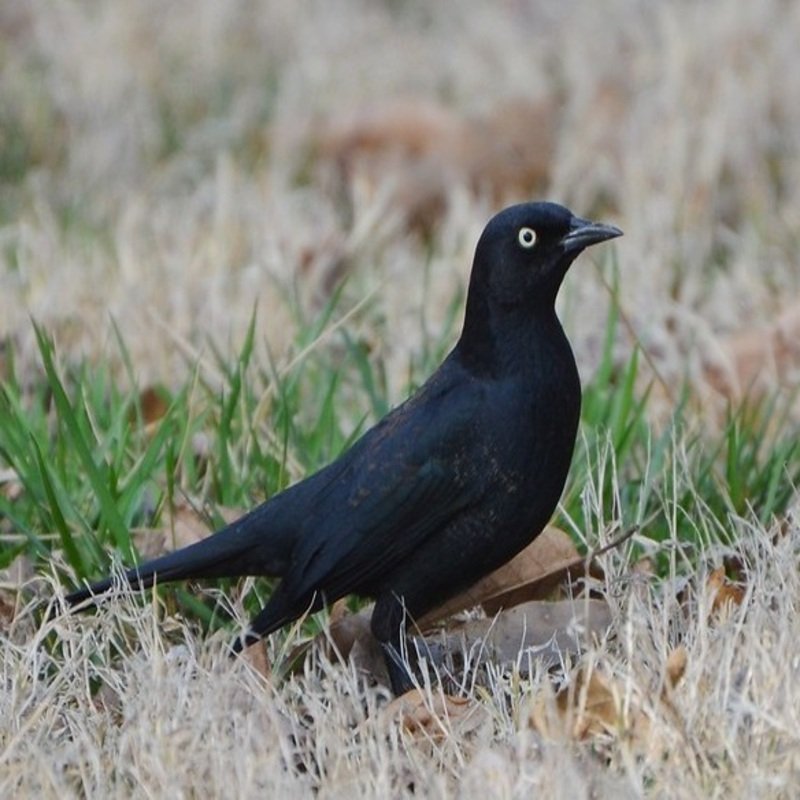The rusty blackbird, Euphagus carolinus is a medium-sized blackbird with grackle-like plumage (“rusty grackle” is an older name for the species). It is a wet forested bird that breeds in boreal forest and muskeg in northern Canada and migrates southeast to the United States during the winter. Previously plentiful, the rusty blackbird has had one of the most precipitous losses of any abundant bird species in recent years, for unknown causes.
Quick Overview: Euphagus Carolinus – Rusty Blackbird
Body size: Around 8.25-9.75 in (21-25 cm) and a weight of 65 g (2.3 oz)
Main colors: Black, Yellow, Gray-brown
Range: Northeastern United States
Migratory Bird: Yes
Best time of the year to see in the U.S.: January, February, December
Conservation Status: Least Concern
Rusty Blackbird Description
Male Rusty Blackbirds may be identified in the winter by their rusty feather edges, pale yellow eye, and buffy eyebrow, and black body. Females are gray-brown with rusty feather edges, pale eyes, and a prominent brow, which contrasts with darker feathers around the eye. Males used for breeding are dark glossy black.

Size
These birds have a length of 8.25-9.75 in (21-25 cm) and a weight of 65 g (2.3 oz). Their wings could range from 13-15 in (33-38 cm).
Feeding
This species mostly forages on the ground, notably around the borders of ponds, streams, and other wetlands. During the winter, it will occasionally eat in trees on pine seeds, fruits, and berries.
Habitat
Throughout Canada and Alaska, they breed in moist temperate coniferous woods and muskeg, which provide a natural breeding ground. In most cases, birds nest around the edges of ponds and marshes, with the cup nest being built in a tree or thick bush, frequently above the water.
Behavior
They eat insects, small fish, and seeds, usually on damp ground or in shallow water. Their preferred way of foraging is to flip leaves and rip at submerged aquatic vegetation. The mast of small-acorn-producing oaks like the willow oak is also noteworthy. Plantation pecan nuts are frequently utilized in various areas. They seldom target small passerine birds but have been spotted killing huge birds like the common snipe. They browse in big groups during migration and wintering, occasionally joining other blackbirds, who also forage in large groups.
Euphagus Carolinus Scientific Classification
- Kingdom: Animalia
- Phylum: Chordata
- Subphylum: Chelicerata
- Class: Aves
- Order: Passeriformes
- Family: Icteridae
- Genus: Euphagus
- Species: Euphagus carolinus
Best time of the year to see
The best time to see these birds in the United States is during the winter season (December to February).
Distribution of the Rusty Blackbird in the USA
From Alaska to southern Canada, northern New York, and northern New England. Winters in southeastern South Dakota and southern New England, Maine, New Hampshire, Vermont, Massachusetts, Rhode Island, Connecticut, Delaware, Maryland, New Jersey, New York, and Pennsylvania all the way down to the Gulf Coast.
The Rusty Blackbird can be found in the following states in the United States – Alabama, Arkansas, Florida, Georgia, Hawaii, Illinois, Indiana, Iowa, Kansas, Kentucky, Louisiana, Michigan, Minnesota, Mississippi, Missouri, Nebraska, North Carolina, North Dakota, Ohio, Oklahoma, South Carolina, South Dakota, Tennessee, Texas, Virginia, West Virginia, and Wisconsin.
